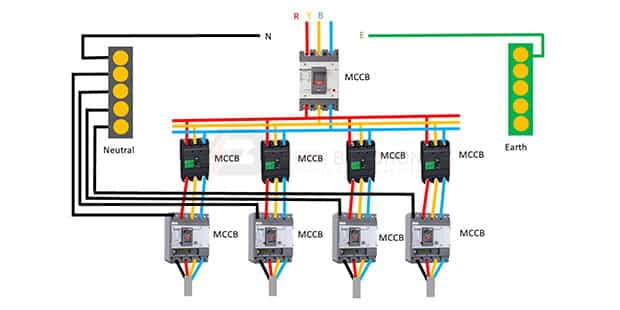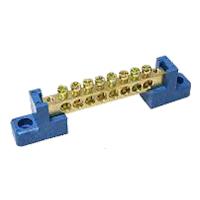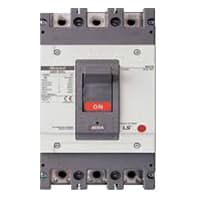MCCB panel board wiring diagram:
This diagram shows how to make an MCCB panel board wiring diagram. In this circuit, we use a neutral busbar, an earth busbar, a main TP MCCB ( Tripple Pole Molded Case Circuit Breaker ), some TP MCCB ( Tripple Pole Molded Case Circuit Breaker ), and some FP MCCB ( Four Pole Molded Case Circuit Breaker ). First, we need to connect the MCCB with the power source, then connect the other MCCB with the power source like in our diagram.
Advertisements
Components needed For this Project:
You can get the components from any of the sites below:
*Please note: These are affiliate links. I may make a commission if you buy the components through these links. I would appreciate your support in this way!
Advertisements
Components used to make the MCCB panel board wiring diagram:
A busbar is a type of Electrical conductor. It is made of copper brass or aluminum. Busbar is most commonly used in factories. We supply the power from the transformer to the busbar. We take the electricity from this busbar to the circuit breaker. The advantage of using a busbar is that through it we can provide multiple power connections in multiple places very easily. How many thick copper bars are aggregates of busbars? A copper bar is rectangular (rectangular) copper type or triangular in shape.
02. MCCB:
The MCCB consists of a bimetallic sheet that expands and contracts when the temperature of the MCCB changes. Due to overload, the bimetallic strip will start to bend and eventually. it will trip if more current flows in the circuit than the predetermined current. The trip mechanism opens the breaker. MCCB stands for Molded Case Circuit Breaker. It is another type of electrical protection device that is used when the load current exceeds the limit of a miniature circuit breaker. The MCCB provides Protection against Overload, and Short Circuit Faults and is also used for Switching the Circuits.
Thank You for visiting the website. Keep visiting for more Updates.
Frequently asked questions
MCCB stands for Molded Case Circuit Breaker. It is another type of electrical protection device that is used when the load current flow exceeds the limit of a miniature circuit diagram breaker. The MCCB protects against overload, and short circuit diagram faults and is also used for switching the circuit diagram.
It relies on a bimetallic mechanism which, when heated by an overcurrent flow, bends to disconnect the circuit diagram. The magnetic mechanism was primarily a solenoid and meant to provide an instantaneous (or almost instantaneous) trip for more than serious faults like short circuit diagram.
The full form of MCCB is Moulded Case Circuit diagram Breaker. They are capable of handling extremely high current diagrams, up to 1000A. They are extensively used in industrial applications where large electrical device loads need to be safeguarded. Read Also: Understanding the Benefits of Using Moulded Case Circuit Diagram Breakers (Mccb).
An MCCB comes with an interrupt rating between 10-k to 200-k amperes, whereas the interrupt rating of an MCB is up to 1800 amperes. Therefore, the MCCB is commonly used for industrial purposes like heavy-duty appliances and machinery, while the MCB is the best for lower electrical loads or smaller appliances.
Breaking capacity can be defined as the maximum level of fault current that can be safely cleared. It is the highest fault current flow that the MCCB could trip without being damaged permanently. The MCCB would be reusable after interrupting a fault, as long as it doesn't exceed the value.
Read more Single Phase Wiring
What is a kilowatt-hour (kWh) | kwh formula | What does kwh mean
Introduction to Electrical Units and CircuitskW and kWh on your electricity bill As your home uses electricity during...
What is the Difference Between kVA | What does KVA mean | kVA formula
Difference Between KVA ExplainedWhat does KVA Mean? There are technical terms aplenty when it comes to generators, and...
Power Factor | Power Unit | Energy | Electricity Unit
Power factor definition | Calculating Power FactorPower Factor Values In a purely resistive circuit, the power factor...



0 Comments